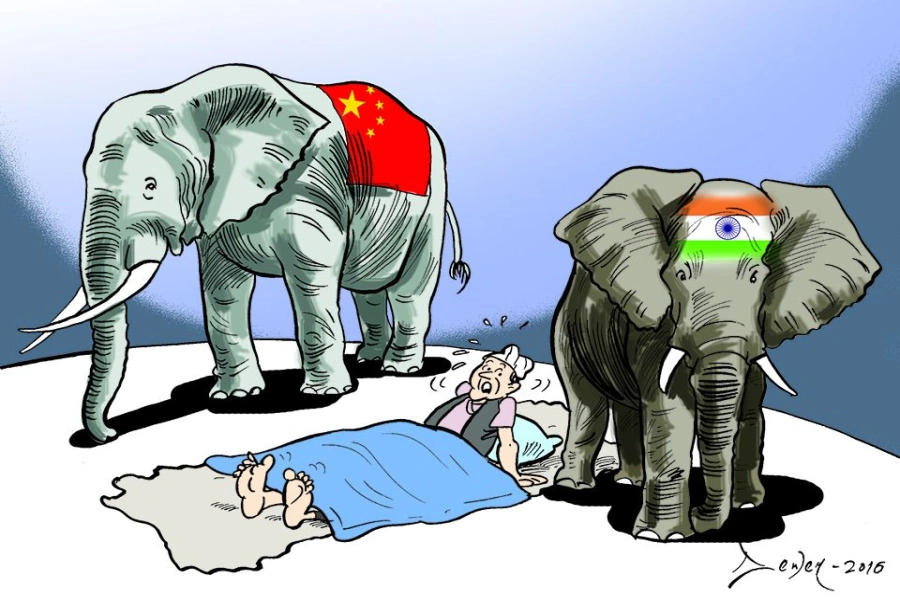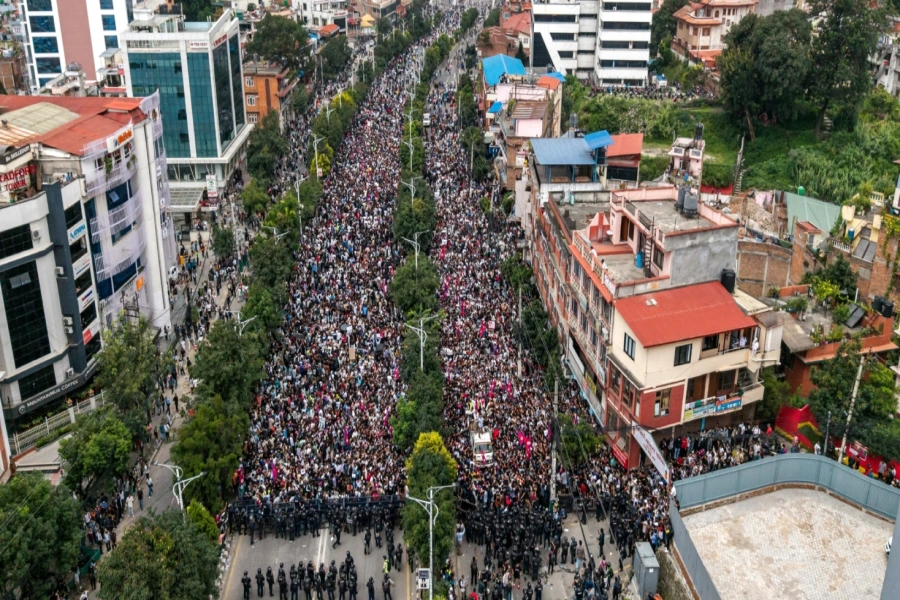The Debt to GDP ratio has reached 41.5% and the debt figure amounted to NRs 2 trillion this year. So, the amortization schedule shows that we are required to pay almost 10 percent of our total revenue for debt repayment. If the creditors hesitate to fund sufficient loans, once we reach an unsustainable level of the debt to GDP ratio, only Lord Pashupatinath knows what’s going to run our state!
Have you ever dreamt of becoming a millionaire or billionaire? If yes, the dream may soon come true! The irony is that it will not be due to economic development and inclusive prosperity but because of rapid decline in the value of currency, a phenomenon called hyperinflation. And in this situation, governments often issue currencies of higher denominations like million or billion rupees for increasing their coffers with seigniorage (profits gained by the government from money printing). And millions of rupees will be able to purchase a pitiful amount of goods and services only, say a liter of milk. So, there is a high chance that our sustained economic misdemeanor, God forbid, makes us all millionaires and billionaires sans purchasing value.
Hyperinflation is the condition when prices of goods hike up uncontrollably, equivalent to almost doubling of prices within a couple of days or months. More specifically, in hyperinflation, prices of goods and services increase at the rate of 50 percent per month or 500 percent per year, according to Professor Cagan of Columbia University. Economists often purport that living in a country with hyperinflation is the perfect simulation of life in Hell.
Citizens all over the globe, including Nepal, are now troubled by excessive inflation due to the Russia-Ukraine war, oil price hike and inflationary policies adopted during COVID-19. For Nepal, the inflation threshold set by Nepal Rastra Bank was 7 percent, but it has already reached 8.5% in mid-October 2022. As one of the major causes of inflation is import price and fluctuating weather conditions, the Nepali inflation control mechanism is not fully under the control of the central bank. Thus, a careful enquiry is required to assess the risk of hyperinflation in Nepal.
The economic history of the world and recent episodes of hyperinflation in Zimbabwe (2008) and Venezuela (2016) show a commonality in the causes of hyperinflation. Liping He, professor at Beijing Normal University, in his book ‘Hyperinflation- A World History’ pinpointed its three major causes: extreme economic mismanagement, deterioration in the international relations and haphazard policy decisions. So, fitting the contemporary Nepali economic fundamentals and political scenario, it’s a no brainer to say that Nepal is slowly sliding into the slippery slope of Hyperinflation.
Politics and economics of pandemic

Govt living beyond its means
Be it an individual or the government, it’s advisable to live within its means. However, the Government of Nepal, being a resource-deficit country, has its own constraints and resorts to deficit financing. For the year 2021/22, GoN had revenue of NRs 1068 billion while it incurred expenses of NRs 1296 billion. This is not a big issue, if the government revenues are invested in profitable projects that generate income or public welfare over the longer term. But a huge chunk (90%) of the hard-earned revenue has been spent on recurrent expenditure alone. And the miniscule budget allocated for capital expenditure has to rely almost on foreign debts and grants. The grant amount can be expected to reduce further, as we march towards 2026, the year when we are planning to get upgraded from the LDC status. The Debt to GDP ratio has reached 41.5% and the debt figure amounted to NRs 2 trillion this year. So, the amortization schedule shows that we are required to pay almost 10 percent of our total revenue for debt repayment. If the creditors hesitate to fund sufficient loans, once we reach an unsustainable level of the debt to GDP ratio, only Lord Pashupatinath knows what’s going to run our state!
Another instance that the government is living beyond its means is the profligate social security allowances. There are about 35 lakhs 70 thousand beneficiaries who receive direct cash transfers from the government. About Rs 68 billion was distributed in FY 2020-21 alone for this purpose. Now, due to the lowering of the eligibility age by the outgoing government, more than 113,000 beneficiaries have increased, and Rs 105 billion has been allocated for the purpose in the 2022-23 budget. This amounts to almost 10 percent of the estimated government revenue. Such populist policies, with a blind eye to the economic reality, is leading us to quagmire.
Policy failures
Firstly, the policymakers are found to be careless with the basics of project management, given the Return of Investment (ROI) and Payback Period (PBP) of some big investments like Gautam Buddha International Airport (NRs 40 billion), Chovar Dry Port (NRs 1.6 billion), and many more. The infinite extension of deadlines in projects such as Melamchi Drinking Water Project (started in 1998), Budhi Gandaki Hydropower Project (pre-feasibility study in 1984), Kathmandu Ring Road Improvement Project (started in June 2013) etc showcases the inefficiency in investment policy.
Further, there are many hurdles for international investors to invest in Nepal, thanks to the impractical Foreign Investment policy. The threshold of Rs 50 million was recently reduced to Rs 20 million, as an example of carelessness in the previous policy. Next, the government’s populist policy decision to increase social security allowances, despite its shrinking revenue, is like digging its own grave. Further, the promotion of foreign employment to the youths by the state authorities itself is the height of governmental policy failure, instead of creating opportunities for employment within the national boundary. The country literally produces nothing except for its young citizens, only to export them to the Gulf of Deaths. In these dire times, too, no serious policies are put and formulated to attract its skilled citizens around the globe. Economically, it depends largely upon its southern neighbor sharing 60 percent of its total trade. And, with the history of blockades time and again (2019, 2027, 2045, 2072 BS) from India, we cannot avoid the possibility of deadly ramifications if the geopolitical turmoil ignites any time. Given our excessive dependence upon the big white elephant of the south, it also has another key, pegged exchange rate, to choke our economy whenever it wants. No policy homework is done by authorities to deal with these possible scenarios.
International isolation
With the shifting of the ‘economic center of gravity’ toward the Himalayas, it’s inevitable that a geopolitical struggle will take place among the west and south east asia to influence Nepal and keep her on their side. Without a delicate balance in the relations with India, China and its neighbor of the sky (USA) through excellent diplomacy, Nepal will be at the risk of international isolation. The recent episodes of criticism against the MCC project of the USA, dubious boundary debate of Kali River with India, criticism for increasing influence of China to Nepal’s Communist parties denotes our vulnerable position. Nepal is now excessively dependent upon imported goods for consumption, remittance for income and foreign debts for covering budget deficit. So, the sudden deterioration of international relations by any cause would severely impact its demand and supply of goods in the market, scarcity of debt will occur and add pressure to the government coffers. For a country that produces literally nothing to sell, such a scenario is a push into the abyss of hyperinflation.
Brewing up a storm
Fiscal discipline is a fairytale for the drivers of the Nepali economy. Misuse of government revenue is rampant, aided by corruption (corruption rank-117th most corrupt out of 180 countries on study of Transparency International 2021). Meager sources of revenue and very poor productivity ails the government budget. In recent times, the government is relying on debt financing to fill up the gap of budget deficit. But, until when? Next, policies are frequently tampered with by the change in governments. Long term consequences are not considered while making investment decisions. Also, our independent institutions are being constantly weakened by government intervention for political causes, be it the Nepal Rastra Bank, the judiciary, and many more. Adding insult to injury, Nepal’s relation with its international financial partners is deteriorating due to diplomatic weakness, and political ambition of a few elite politicians.
In this juncture, let's imagine a scenario, if our debt to GDP ratio rises above 100% or a war occurs in the neighborhood, or climate change causes devastating effects - one of them being a probable trigger in the next decade. Then, the credibility of Nepal will degrade, and creditors will either stop lending or charge us high interest rates. The repayment obligation would be ballooned by then and the government would not have sufficient revenue to fund itself and repay the loans. In that case, if international agencies or countries stop lending us the much-needed money, the last resort is money printing either physically or digitally, which is actually the theft of money by the government from the citizens’ pockets. Then there comes the cancer of the economy - hyperinflation which is a situation where you have millions of rupees but are not able to buy even the necessities! Prices double instantly and there is no motivation for doing work or trade or anything except the barter.
That’s why, we must immediately review our history of the mid 1980’s when the nation had plummeted into a BoP crisis due to excessive government spending and economic mismanagement. That time, international agencies helped us to cope with it. There is no guarantee that they always will. Lastly, the author fears the future as the only thing that humans learn from history is that humans learn nothing from history.



































